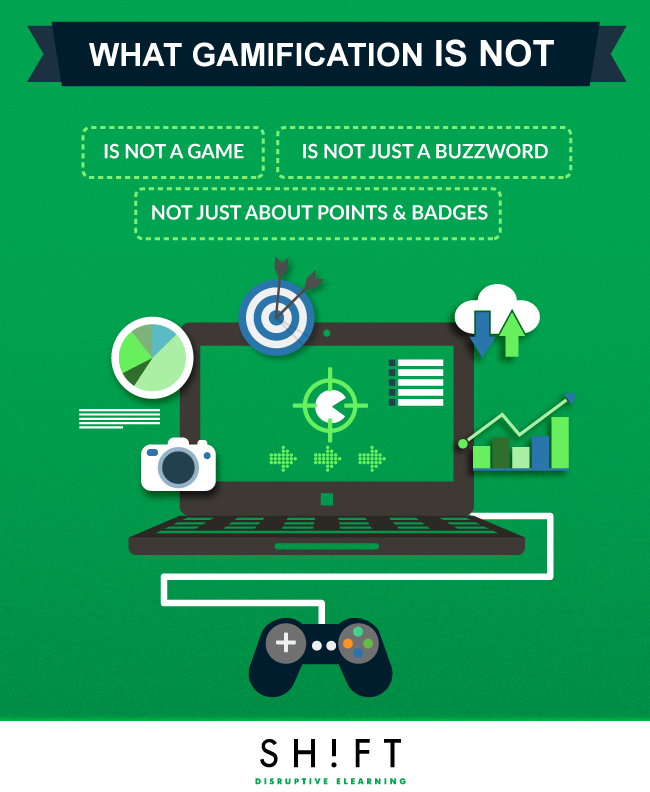What is Gamification?
Most people describe Gamification as “the application of game elements to non-game contexts to increase user engagement". But we especially like Karl Kapp's definition: "Gamification is the cover to add the interactivity, engagement and immersion that leads to good learning".
What Gamification is NOT
Misunderstanding gamification directly affects the way you use it for developing gamified eLearning.
Let’s get clear.

Gamification is NOT a game. It’s not even game-based learning. It does not require e-learning students to play games, either electronically or with toys.
In essence, gamification is not even about designing full-fledged games. It is simply about using game mechanics, and elements to make practical day-to-day activities (like eLearning) more compelling and engaging.
This graphic compares the differences between gamification vs. game-based learning.
When gamifying learning, remember that use of game elements is not same as creating a game for the content. The aim is to enhance the teaching process and hence make it more fun and engaging but not to replace teaching with playing. Don't let the gamification steal the show!
Further Reads:
- Why Gamification’s Not a Game
- It's Not a Game: It's Gamification
- Gamification Does Not Mean Playing Games
- Gamification, Game-based Learning, Serious Games: Any Difference?
Gamification is more than ranking systems, scoreboards, and badges
Gamification is much more than points, ranking systems and badges. A good gamified eLearning course concentrates on intrinsic instead of external motivating factors and emotional engagement. This means that a gamified eLearning course can be gamified without ever offering a point, badge or status icon to the learner.
The purpose gamifying an eLearning course is to encourage learners to engage in desired learning behavior by taking advantage of the human psychological predisposition towards gaming.
Gamification is meant to assign real benefits for the learner, the training department, and the organization as a whole. Hence, your gamification-thinking must go beyond just developing appoint system where points are collected for the sake of collecting badges. Though this can be a good start and leverage one’s competitive drive, it should be seen as a means to an end (the initial boost) and not an end in itself.
Read: Points and Badges ≠ Gamification
How to Make it Work
Poorly executed gamification results in cost-intensive learning activities that not only disengage learners but also disenchant them about the effectiveness of gamified learning.
To make it work, your gamified eLearning courses must be:
- Learner-centered: — Gamification should help your learners achieve their learning objectives.
- Useful: The content should be relevant and focused on real-life scenarios.
- Focused on content and design, not technology: As Karl Kapp says: "Gamification is not bounded by technology or the need to be delivered online; it doesn’t have to be digital. Instead, gamification is a design sensibility".
For gamification to deliver expected results, it is imperative that you first assess your existing eLearning strategy. Consider whether gamification can harmoniously fit in with your training and eLearning strategy before investing in it.
Read: 6 Tips for Successful Gamification in E-Learning
So, Should You Gamify Your eLearning Course?
This depends on your training goals and the needs of the organization. Gamifying just for the sake of making the course more engaging and fun is never cost-effective. The task of your organization is to increase the productive potential of your resources and to keep you talent pool market competitive, and not to create an experience of pleasure. Make sure it's always related to your business objectives.
However, if your objective is to boost enrollment and higher engagement and results from your eLearning programs, gamification is a great option, especially if the program is mandatory.
Your choice begins with your organizational objectives (pedagogical and learning), the content that your department believes needs to be gamified, and understanding your target learners. Once these objectives are clear, gamification will dramatically boost engagement and retention. Employees will learn with fun, and perform!
Gamification Examples
Gamification examples to check out:
- Ambition: A gamification tool that adapted Fantasy Sports Competition to the office environment.
- 20 Examples of Games or Gamification for Sales Training
- Greate Gamification Examples in Training
- Volkswagen’s Fun Theory



